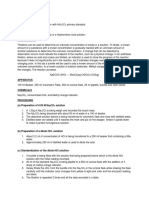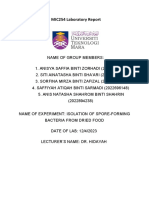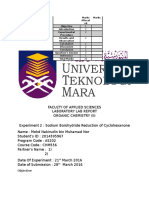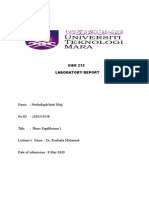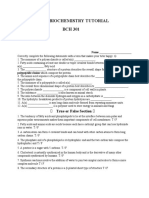Chm256 Odl Exp 1 2 3 Lab Report
Uploaded by
maya adamChm256 Odl Exp 1 2 3 Lab Report
Uploaded by
maya adamlOMoARcPSD|8508305
CHM256 ODL EXP 1 2 3 LAB Report
Basic Analytical Chemistry (Universiti Teknologi MARA)
StuDocu is not sponsored or endorsed by any college or university
Downloaded by aiman qistina (ai.manqis305@gmail.com)
lOMoARcPSD|8508305
__________________________________________
BASIC ANALYTICAL
CHEMISTRY CHM 256
______________________________________
INDIVIDUAL LABORATORY REPORT
EXP 1: FULL LAB REPORT
EXP 2 & 3: CALCULATIONS
EXPERIMENT NO & 1) STANDARDIZATION OF HCl SOLUTION WITH Na2CO3
TITLE PRIMARY STANDARD
2) DETERMINATION OF ETHANOIC ACID CONTENT IN
VINEGAR
3) DETERMINATION OF CALCIUM CARBONATE CONTENT IN
EGGSHELL BY BACK TITRATION
NAME MUHAMMAD NOR FARIES BIN MD ASID
GROUP AS1204K
STUDENT ID 2018800892
LECTURER’S NAME MADAM ADIBATUL HUSNA
DATE OF SUBMISSION 1st JUNE 2020
Downloaded by aiman qistina (ai.manqis305@gmail.com)
lOMoARcPSD|8508305
EXPERIMENT 1
STANDARDIZATION OF HCl SOLUTION WITH Na2CO3 PRIMARY STANDARD
Objective
To determine the exact molarity of a hydrochloric acid solution
Introduction
Pure sodium carbonate is a non-hygroscopic primary standard reagent. A standard solution
prepared by dissolving a known amount of the solid Na2CO3 in a fixed volume can be used to
standardize other acid solutions. The aim of the experiment is to prepare a standard solution of
exact concentration which can later be used to standardize other solutions. HCl is not a primary
standard. Thus, after a dilute HCl solution is prepared, it has to be standardized with a primary
standard solution in order to determine its concentration accurately. In this experiment a standard
Na2CO3 solution and a dilute HCl solution will be prepared. The HCl solution will later be
standardized against the Na2CO3 solution. The reaction between HCl and Na2CO3 is as follows.
2 HCl + Na2CO3 → 2 NaCl + H2O + CO2
Apparatus
100 mL beaker, 250 mL volumetric flask ,250 mL conical flask ,25 mL pipette, Burette, Retort
stand
Chemicals
Na2CO3, Concentrated HCl, Methyl Orange Indicator
Downloaded by aiman qistina (ai.manqis305@gmail.com)
lOMoARcPSD|8508305
Procedure
(a) Preparation of 0.05 M Na2CO3 solution
1. About 1.33 g of Na2CO3 was weighted accurately. The exact mass of the Na2CO3 recorded.
2. The Na2CO3 was dissolved in about 50 mL water in a 100 mL beaker.
3. The solution was transfered into a 250 mL volumetric flask. The beaker was rinsed with
distilled water.
4. The distilled water was added to the mark. The flask was stopped by using a stopper. The flask
was shaked it by turning it upside down a few times to make the solution homogeneous
(b) Preparation of a dilute HCl solution
1. About 2.2 mL of concentrated HCl was transfered into a 250 mL beaker containing a little
water.
2. The acid was diluted to approximately 250 mL with distilled water
(c) Standardization of the dilute HCl solution
1. The burette was filled with the dilute HCl solution prepared in (b) above. Record the initial
burette reading.
2. 25.0 mL was pipetted of the standard Na2CO3 into a 250 mL conical flask. 2-3 drops of
methyl orange indicator was added.
3. The Na2CO3 was titrated in the conical flask with the HCl from the burette slowly while
shaking the flask until the indicator colour change from yellow to red. The
burette reading at the end point of the titration was recorded.
4.The titration was repeated 3 times. All the data was recorded in a table as shown in the
datasheet.
5. The exact molarity of the HCl solution was calculated
Downloaded by aiman qistina (ai.manqis305@gmail.com)
lOMoARcPSD|8508305
Results
1) Weight of Na2CO3 used : 1.333 g
2) Standardization of HCL with Na2CO3 solution
Rough 1 2 3
Initial burette reading 0.00 0.00 0.00 0.00
(mL)
Final burette reading 23.40 22.50 21.80 22.20
(mL)
Volume of HCL used 23.40 22.50 21.80 22.20
(mL)
Average of volume of HCl used ( from titration 1,2,3) = 22.17 mL
3 ) Calculate the molarity of the HCL solution.
Na2CO3 + 2 HCl -----> 2NaCl+ H2O + CO2
Number of mole Na2CO3 = Mass / Molar Mass
= 1.333g / 106 g/mol
= 0.01257 mol Na2CO3
1 mol Na2CO3 = 2 mol HCl
0.01257 moles of Na2CO3 = 2 mol of HCl / 1 mol Na2CO3
= 0.02514 mol of HCl
Molarity Of HCl = No of mol / volume of solute
= 0.02514 mol / 0.02217 L
= 1.134 M
Downloaded by aiman qistina (ai.manqis305@gmail.com)
lOMoARcPSD|8508305
Discussion
In this experiment, determine the exact molarity of a solution of hydrochloric acid to achieve the
objective. The experiment aims at creating a specific solution of exact concentration that can be
used later to standardize other solutions
This experiment involves standardizing a hydrochloric acid solution using two pimary standards,
sodium carbonate. Standardization of an unknown solution means interacting with another solution
the concentration of which is already well known. Since HCl is not a primary standard, the dilute
HCl has to be standardized with a primary standard solution to accurately determine its
concentration. When the equivalence point is reached, the addition of an indicator such as methyl
orange indicator provides a visual sign (a change of colour). If only enough of the standard solution
has been added to the unknown solution to exactly neutralize it. I can determine a very accurate
value for the hydrochloric acid concentration by calculating how much of the salt solution is
needed to neutralize the hydrochloric acid.
The weight of Na2CO3 used in this experiment is 1.333g. The experiment is repeated three times
to get the average value of HCl which is 22.17 mL. The equation had been given in the lab manual
which is Na2CO3 + 2 HCl -----> 2NaCl+ H2O + CO2 . So we can find the number of mole
Na2CO3 and number of mole of HCl.
To calculate the molarity of the HCl solution, number of mole of Na2CO3 and number of mole of
HCl must be find by using formula number of moles equal to mass divided by molar mass. Then
lastly, the formula of molarity equal to number of mole of HCl divided by volume of solute was
been used to find molarity of HCl which is 1.134 M
The formula MaVa = MbVb is used for calculating the molarity of the concentrated HCl. Ma is
the concentrated HCl molarity, Mb is HCl molarity, Va is concentrated HCl volume while Vb is
HCl volume. All of the information was substituted, and the concentrated HCl molarity is 11.43
mol / L.
The error found in this experiment is the eyes of the experimenter which are not perpendicular to
the pipette scale. Secondly, to get the average value the experimenter should repeat the experiments
for three times. Eventually, the experiments do not warn as soon as the solution turns to red. Thus,
the experimenter's eyes must be perpendicular to the scale for the potential guidance, and also be
vigilant and alert in the laboratory.
Downloaded by aiman qistina (ai.manqis305@gmail.com)
lOMoARcPSD|8508305
Question
Calculate the molarity of the concentrated HCL.
MaVa = MbVb
Ma ( 2.2x10-3 L ) = 1.134 M x 0.02217 L
Ma = 0.02514/2.2x10-3
Ma = 11.43 mol/L
Conclusion
The concentration of hydrochloric acid (HCl) solution which was collected during the
experiment was 1.134 M which is approximately at the predicted concentration. Other than that,
it has been proven that the purity of the standard solution is related to the analyte concentration.
The results obtained are appropriate and thus the objective of the experiment fulfilled.
References
1. Opoku, E. (2014, March 14). Experiment on the standardization of acid solution. Retrieved from
https://www.slideshare.net/Ernest13/experiment-on-the-standardization-of-acid-solution
2. isenbon123. (n.d.). Conclusion The standardization of HCl and NaOH required the use of titration:
Course Hero. Retrieved from https://www.coursehero.com/file/p1irn0hj/Conclusion-The-
standardization-of-HCl-and-NaOH-required-the-use-of-titration/
Downloaded by aiman qistina (ai.manqis305@gmail.com)
lOMoARcPSD|8508305
EXPERIMENT 2
DETERMINATION OF ETHANOIC ACID CONTENT IN VINEGAR
RESULTS (FROM PREVIOUS STUDENTS)
1. Standardization of NaOH with KHC8H4O4 solution
1 2 3
Initial burett reading 0.00 0.00 0.00
(mL)
Final burette reading 25.50 25.40 25.50
(mL)
Volume of NaOH used 25.50 25.40 25.50
(mL)
Average of volume NaOH used (from titration 1,2,3) = 25.47 mL
2. Titration of diluted vinegar with NaOHsolution
1 2 3
Initial burette reading 0.00 0.00 0.00
(mL)
Final burette reading 33.80 33.00 33.30
(mL)
Volume of NaOH used 33.80 33.00 33.30
(mL)
Average of volume NaOH used (from titration 1,2,3) = 33.37 mL
Downloaded by aiman qistina (ai.manqis305@gmail.com)
lOMoARcPSD|8508305
Questions
1. Calculate the molarity of the NaOH solution.
NaOH + KHC8H4O4 → KNaC8H4O4 + H2O
MaVa / MbVb = a / b
Ma = Molarity of NaOH Solution
Va = Volume of NaOH Solution = 0.02547 L
Mb = Molarity of KHC8H4O4 = 0.1 M
Vb = Volume of KHC8H4O4 = 0.025 L
Ma = ( a/b ) ( MbVb ) / Va
= (1/1) ( 0.1 mol/L x 0.025 L ) / 0.02547 L
= 0.0982 M of NaOH #
Molarity = No. of mole / Volume
Mole of KHC8H4O4 = (0.1 mol/L) ( 0.025L )
= 2.5 X 10-3 mol of KHC8H4O4
1 mole of KHC8H4O4 : 1 mole of NaOH
Molarity of NaOH = 2.5 x 10-3 mol / 0.02547 L
= 0.0982 mol/L
Downloaded by aiman qistina (ai.manqis305@gmail.com)
lOMoARcPSD|8508305
2. Calculate the molarity of ethanoic acid in the diluted vinegar.
NaOH + CH3COOH NaCH3COO + H2O
MaVa = MbVb
Ma = Molarity of Ethanoic Acid in the diluted vinegar
Va = Volume of Ethanoic Acid in the diluted vinegar = 0.025L
Mb = Molarity of NaOH = 0.0982 M
Vb = Volume of NaOH = 33.37mL x 1L/1000mL = 0.03337L
Ma = ( MbVb ) / Va
= ( 0.0982 M x 0.03337 L ) / 0.025L
= 0.131 M of ethanoic acid in diluted vinegar
3. Calculate the molarity of ethanoic acid in the vinegar sample
MaVa = MbVb
Ma = Molarity of Ethanoic Acid in the Vinegar Sample
Va = Volume of Ethanoic Acid in the Vinegar Sample = 25mL x ( 1L/1000mL) =0.025L
Mb = Molarity of Ethanoic Acid in Diluted Vinegar = 0.131 mol/L
Vb = Volume of Ethanoic Acid in Diluted Vinegar = 250mL x ( 1L/1000mL) = 0.25L
Ma ( 0.025 L ) = ( 0.131 mol/L ) ( 0.25L )
Ma = 1.31 M of Ethanoic Acid in the Vinegar Sample
Downloaded by aiman qistina (ai.manqis305@gmail.com)
lOMoARcPSD|8508305
4. Calculate the concentration of ethanoic acid (g/L) in the vinegar.
Molarity = No. of mole / Volume
No of mole = 0.0982 mol/L x 0.03337 L
= 3.277x10-3 mol of NaOH
Mole = Mass / Molar mass
Mole of ethanoic acid = 3.277x10-3 mol
Molar Mass of ethanoic acid = 60.06 g/mol
Mass = ( 3.277x10-3 mol ) ( 60.06 g/mol )
= 0.198 g of ethanoic acid
The Concentration Of Ethanoic Acid (g/L)
= Weight of Solute (g) / Volume of Solute (L)
Volume of Ethanoic Acid = 0.025 L
Concentration (g/L) = (0.198g) / ( 0.025L)
= 7.92 g/L
Downloaded by aiman qistina (ai.manqis305@gmail.com)
lOMoARcPSD|8508305
5. Calculate the percent (w/v) of ethanoic acid in the vinegar.
Weight percent (w/v) = weight of solute (g) / Volume of solute(mL) x 100%
Mass of Ethanoic Acid = 0.197g
Volume of Ethanoic Acid = 25 mL
% (w/v) = (0.198g / 25 mL) X 100%
= 0.792 %
Downloaded by aiman qistina (ai.manqis305@gmail.com)
lOMoARcPSD|8508305
EXPERIMENT 3
DETERMINATION OF CALCIUM CARBONATE CONTENT IN EGGSHELL BY BACK TITRATION
RESULTS (FROM PREVIOUS STUDENTS)
1. Standardization of NaOH with KHC8H4O4 solution.
Molarity of KHC8H4O4 solution: (0.25 M)
1 2 3
Initial burette reading 0.00 0.00 0.00
(mL)
Final burette reading 15.70 15.50 15.50
(mL)
Volume of NaOH used 15.70 15.50 15.50
(mL)
Average of volume NaOH used (from titration 1,2,3) = 15.57 mL
2. Standardization of HCl with NaOH solution
1 2 3
Initial burette reading 0.00 0.00 0.00
(mL)
Final burette reading 28.40 25.50 28.60
(mL)
Volume of NaOH used 28.40 25.50 28.60
(mL)
Average of volume NaOH used (from titration 1,2,3) = 27.50 mL
3. Analysis with eggshell
1 2
Mass of the egg shell (g) 1.0014 1.0020
Initial of burette reading (mL) 0.00 0.00
Final burette reading (mL) 17.20 18.60
Volume of NaOH used (mL) 17.20 18.60
Downloaded by aiman qistina (ai.manqis305@gmail.com)
lOMoARcPSD|8508305
Question
1. Write balanced chemical equation for reaction during titration in procedure (A) and describe
the reason of potassium hydrogen phthalate used to standardize anothersolution.
NaOH + KHC8H4O4 ⎯→ KNaC8H4O4 + H2O
The potassium hydrogen phthalate used as standardize is to determine the concentration of
solution by titration with a primary standard solution such as potassium hydrogen phthalate itself
or with a solution with unknown concentration.
2. Calculate the concentration of the NaOH solution.
Concentration of KHC8H4O4 = no. of moles / volume of KHC8H4O4
Molarity of KHC8H4O4 = 0.25M
Volume of KHC8H4O4 = 0.02L
Volume of NaOH = 0.01557 L
Molar Mass of NaOH = 39.997 g/mol
No. of moles of KHC8H4O4 = Concentration of KHC8H4O4 x Volume of KHC8H4O4
= ( 0.25 mol/L ) ( 0.02L )
= 5X10-3 mol of KHC8H4O4
NaOH + KHC8H4O4 ⎯→ KNaC8H4O4 + H2O
1 mole of KHC8H4O4 1 mole of NaOH
5.0x10-3 moles of KHC8H4O4 5.0x10-3 moles of NaOH
Molarity of NaOH = 5.0x10−3 moles0.01557L = 0.321M of NaOH solution
Concentration of NaOH (g/L) = Molarity (mol/L) x Molar Mass ( g/mol)
= 0.321 mol/L X 39.997 g/mol
= 12.84 g/L
Downloaded by aiman qistina (ai.manqis305@gmail.com)
lOMoARcPSD|8508305
3. Calculate the concentration of the HCl solution.
MaVa = MbVb
Ma = Concentration of HCl Solution
Va = Volume of HCl solution = 0.01 L
Mb = Concentration of NaOH = 0.321 M
Vb = Volume of NaOH = 0.0275 L
Molar Mass of HCl = 36.46 g/mol
Ma(0.01L) = 0.321(0.02750mL)
Ma(0.01L)=8.83x10-3
Ma= 0.883M of HCl solution
Concentration of HCl (g/L) = Molarity (mol/L) x Molar Mass ( g/mol)
= (0.883 mol/L) ( 36.46 g/mol )
= 32.19 g/L
Downloaded by aiman qistina (ai.manqis305@gmail.com)
lOMoARcPSD|8508305
4. Calculate the percentage by weight (w/w) of CaCO3 in the eggshell in each replicate.
a)
Calculate HCl (added) :
Volume of HCl added = 25mL = 0.025L
Concentration of HCl =0.883M
∴ No. of mole = concentration x volume (L)
= 0.883 M x 0.025L
= 0.0221 mol of HCl ( Added )
Calculate HCl (left) :
Volume of NaOH used = 17.20mL = 0.01720 L
Concentration of NaOH = 0.321M
∴ No. of mole NaOH = Concentration x Volume (L)
= 0.321M x 0.01720L
= 5.52x10-3mol of NaOH
HCl + NaOH → NaCl + H2O
1 mole of NaOH → 1 mole of HCl
5.52x10-3mole of NaOH → 5.52x10-3mole of HCl ( Left )
Calculate HCl (used) = No.of mole of HCl (Added) – No. of mole HCl (left)
= 0.022mole - 5.52x10-3mole
= 0.01648 mol of HCl
CaCO3(s) + 2 HCl(aq) ⎯→ CaCl2(aq) + H2O(l) + CO2(g)
1 mole of CaCO3 → 2 mole of HCl
x mole of CaCO3 → 0.01648 mole of HCl
x mole of CaCO3 = 0.01648 / 2
= 0.00824 mole of CaCO3
Mass of CaCO3 = No. of mole x MW of CaCO3 Percentage by weight (w/w) =
= 0.00824 mol x 100 g/mol 0.824g / 1.0014g x 100% = 82.28 %
= 0.824 g
Downloaded by aiman qistina (ai.manqis305@gmail.com)
lOMoARcPSD|8508305
b)
Calculate HCl (added) :
Volume of HCl added =25mL =0.025L
Concentration of HCl =0.883M
∴ No. of mole = concentration x volume (L)
= 0.883M x 0.025L
= 0.022 mol Of HCl (Added)
Calculate HCl (left) :
Volume of NaOH used = 18.60mL = 0.01860L
Concentration of NaOH = 0.321M
∴ No. of mole NaOH = Concentration x Volume (L)
= 0.321M x 0.01860L
= 5.97x10-3mol Of NaOH
HCl + NaOH → NaCl + H2O
1 mole of NaOH → 1 mole of HCl
5.97x10-3 mole of NaOH → 5.97x10-3 mole of HCl (Left )
Calculate HCl (used) = No.of mole of HCl (Added) – No. of mole HCl (left)
= 0.022 mol - 5.97x10-3mol
= 0.01603 mol of HCl
CaCO3(s) + 2 HCl(aq) ⎯→ CaCl2(aq) + H2O(l) + CO2(g)
1 mole of CaCO3 → 2 mole of HCl
x mole of CaCO3 → 0.01603 mol of HCl
x mole of CaCO3 = 0.01603 / 2
= 8.015x 10-3 mole of CaCO3
Mass of CaCO3 = No. of mole x MW of CaCO3 Percentage by weight (w/w) =
= 8.015x 10-3 mole x 100 g/mol 0.8015g / 1.0020g x 100% = 79.99 %
= 0.8015g
Downloaded by aiman qistina (ai.manqis305@gmail.com)
lOMoARcPSD|8508305
5. Calculate the mean percentage by weight (w/w) of CaCO3 in the eggshell.
The mean percentage by weight (w/w) of CaCO3 =
Mean percentage = 82.28 + 79.99 / 2
= 81.135%
Downloaded by aiman qistina (ai.manqis305@gmail.com)
You might also like
- Experiment 3: Extraction and Drying of An Aqueous SolutionNo ratings yetExperiment 3: Extraction and Drying of An Aqueous Solution3 pages
- Chm256 - Experiment 1 - Standardization of HCL With Na2co3 Primary StandardNo ratings yetChm256 - Experiment 1 - Standardization of HCL With Na2co3 Primary Standard6 pages
- CHM 256 Exp1 Standarization of HCL Solution With Na2CO3 Primary StandardNo ratings yetCHM 256 Exp1 Standarization of HCL Solution With Na2CO3 Primary Standard3 pages
- Laboratory Report CHM 213 (Physical Chemistry)No ratings yetLaboratory Report CHM 213 (Physical Chemistry)6 pages
- Experiment 3 - Carboxylic Acid and DerivativesNo ratings yetExperiment 3 - Carboxylic Acid and Derivatives3 pages
- Neutralisation Capacity of Commercial Antacid Tablet25% (4)Neutralisation Capacity of Commercial Antacid Tablet6 pages
- CHM 421 Analytical Chemistry Experiment 8: Determination of Fe in A Ferum Solution by Gravimetric Analysis100% (2)CHM 421 Analytical Chemistry Experiment 8: Determination of Fe in A Ferum Solution by Gravimetric Analysis7 pages
- Lab Report EXP.5 CHM457 Fund. Organic ChemistryNo ratings yetLab Report EXP.5 CHM457 Fund. Organic Chemistry6 pages
- Universiti Teknologi Mara Final Test: Confidential AS/JUL 2022/CHM421No ratings yetUniversiti Teknologi Mara Final Test: Confidential AS/JUL 2022/CHM4214 pages
- Group Assignment Chm138 Experiment 1: Basic Laboratory Technique GROUP: AS1141B1No ratings yetGroup Assignment Chm138 Experiment 1: Basic Laboratory Technique GROUP: AS1141B16 pages
- CHM 421 Analytical Chemistry Experiment 3 - Neutralisation Capacity of Commercial Antacid Tablet - Sodium Hydroxide - Hydrochloric Acid100% (1)CHM 421 Analytical Chemistry Experiment 3 - Neutralisation Capacity of Commercial Antacid Tablet - Sodium Hydroxide - Hydrochloric Acid12 pages
- Sodium Borohydride Reduction of Cyclohexanone100% (6)Sodium Borohydride Reduction of Cyclohexanone6 pages
- Lab Report Exp 3 CHM 524 (Physical Chemistry)No ratings yetLab Report Exp 3 CHM 524 (Physical Chemistry)18 pages
- CHM 421 Analytical Chemistry Experiment 1: Calibration of A Volumetric Flask100% (1)CHM 421 Analytical Chemistry Experiment 1: Calibration of A Volumetric Flask10 pages
- Lab Report (Exp 1) : CHM213 Physical ChemistryNo ratings yetLab Report (Exp 1) : CHM213 Physical Chemistry6 pages
- Experiment 2 - Analysis of An Unknown Vinegar Sample100% (1)Experiment 2 - Analysis of An Unknown Vinegar Sample8 pages
- Preparation of 4-Methylcyclohexene: BackgroundNo ratings yetPreparation of 4-Methylcyclohexene: Background4 pages
- Solder Ball Senju - Sn4.0Ag0.5Cu - 20090630No ratings yetSolder Ball Senju - Sn4.0Ag0.5Cu - 2009063023 pages
- Biochemistry Tutorial BCH 301: True or False SectionNo ratings yetBiochemistry Tutorial BCH 301: True or False Section7 pages
- HPLC Troubleshooting Guide: Bulletin 826BNo ratings yetHPLC Troubleshooting Guide: Bulletin 826B20 pages
- ELFR, The European Lead-Cooled Fast Reactor: L. Mansani Luigi - Mansani@ann - Ansaldo.itNo ratings yetELFR, The European Lead-Cooled Fast Reactor: L. Mansani Luigi - Mansani@ann - Ansaldo.it55 pages
- Enhancing Stress Corrosion Cracking Resistance ofNo ratings yetEnhancing Stress Corrosion Cracking Resistance of11 pages
- Cloruro de potasio-MSDS Ingles-DSW Rev.3No ratings yetCloruro de potasio-MSDS Ingles-DSW Rev.36 pages
- Polytypism in Molybdenite (I) - A Non-Equilibrium Impurity-Induced PhenomenonNo ratings yetPolytypism in Molybdenite (I) - A Non-Equilibrium Impurity-Induced Phenomenon10 pages
- Experiment 3: Extraction and Drying of An Aqueous SolutionExperiment 3: Extraction and Drying of An Aqueous Solution
- Chm256 - Experiment 1 - Standardization of HCL With Na2co3 Primary StandardChm256 - Experiment 1 - Standardization of HCL With Na2co3 Primary Standard
- CHM 256 Exp1 Standarization of HCL Solution With Na2CO3 Primary StandardCHM 256 Exp1 Standarization of HCL Solution With Na2CO3 Primary Standard
- Neutralisation Capacity of Commercial Antacid TabletNeutralisation Capacity of Commercial Antacid Tablet
- CHM 421 Analytical Chemistry Experiment 8: Determination of Fe in A Ferum Solution by Gravimetric AnalysisCHM 421 Analytical Chemistry Experiment 8: Determination of Fe in A Ferum Solution by Gravimetric Analysis
- Universiti Teknologi Mara Final Test: Confidential AS/JUL 2022/CHM421Universiti Teknologi Mara Final Test: Confidential AS/JUL 2022/CHM421
- Group Assignment Chm138 Experiment 1: Basic Laboratory Technique GROUP: AS1141B1Group Assignment Chm138 Experiment 1: Basic Laboratory Technique GROUP: AS1141B1
- CHM 421 Analytical Chemistry Experiment 3 - Neutralisation Capacity of Commercial Antacid Tablet - Sodium Hydroxide - Hydrochloric AcidCHM 421 Analytical Chemistry Experiment 3 - Neutralisation Capacity of Commercial Antacid Tablet - Sodium Hydroxide - Hydrochloric Acid
- CHM 421 Analytical Chemistry Experiment 1: Calibration of A Volumetric FlaskCHM 421 Analytical Chemistry Experiment 1: Calibration of A Volumetric Flask
- Experiment 2 - Analysis of An Unknown Vinegar SampleExperiment 2 - Analysis of An Unknown Vinegar Sample
- Biochemistry Tutorial BCH 301: True or False SectionBiochemistry Tutorial BCH 301: True or False Section
- ELFR, The European Lead-Cooled Fast Reactor: L. Mansani Luigi - Mansani@ann - Ansaldo.itELFR, The European Lead-Cooled Fast Reactor: L. Mansani Luigi - Mansani@ann - Ansaldo.it
- Polytypism in Molybdenite (I) - A Non-Equilibrium Impurity-Induced PhenomenonPolytypism in Molybdenite (I) - A Non-Equilibrium Impurity-Induced Phenomenon







